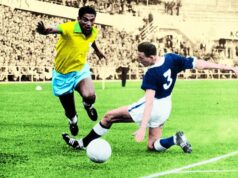Soccer is a demanding and unpredictable sport. During 90 minutes, players constantly move, change direction, and absorb contact. They need to be on the ball in order to triumph, which comes with intense training and preparation. Improving overall balance goes a long way in giving a player an edge on the field and there is no better way to make this happen than to employ skill-based drills. Just take the example of some of the best players ever, like Maradona or Messi, who have an incredible balance.

One leg at a time
The goal of any soccer training is to boost performance, prevent injuries, hone soccer skills, and learn tactics. Balance training does not deviate from these principles, but it is a bit more focused. Some people consider it applicable mostly to young people and kids, which is only half-true at best. Namely, scientists have established that neuromuscular training can enhance balance and related capabilities in adults as well.
Note that balance is not a state, but a dynamic process. The key to understanding it lies in the fact that your body is always moving. Thus, balance encompasses steps, cuts, landing and other movements. The drills emulate what is happening on the field during a match. Unless you are a goalkeeper, soccer is a game that is played mostly on one leg, which is to say that the focus of balance training is practicing skills on a single leg.
Kick your game into overdrive
The ultimate goal is to improve accuracy and power and make the body more coordinated and controlled. Simply standing on one leg does bring benefits, but there are many variations and methods that prove to be even more fruitful. Standing reaches, for instance, are a great workout technique. The players need to touch the cone in front of them by reaching out in a controlled manner.
Furthermore, we have single-leg resisted front and side kicks. Both are performed by standing on one leg with a resistance band around the opposite foot. You are supposed to kick the ball without touching the ground. Single-leg balance volley kicks and push passes work in a similar fashion, but this time around, you stand with one leg on a balance disk and try to perform appropriate moves with the other foot.
One jump ahead
A trampoline single-leg jump header is just what the name suggests: it requires you to jump on the trampoline with one leg and do headers. So, you should not be surprised if you see a soccer player visiting places such as an indoor trampoline park in Las Vegas. A bit more jumping comes in the form of BOSU jumps and kicks. This exercise involves jumping on the ball with both feet and then jumping off it and performing a circular roll.
There are some other exercises that include two players, preferably with similar balance thresholds. One of the most interesting examples is playing slap the hands while standing on one leg. Likewise, there are training programs that implement push the hands, an exercise where players try to push each other off balance. The loser is the first one to make a step.
Of course, there are other types of exercises that do the trick, so feel free to explore the world of soccer balance on your own. Seek exercises that enable you to put your full force behind a kick or pass. What is more, you want to be able to shift your weight appropriately during the match. Do not let other players knock you off the ball easily and hold your ground. Prevent your body from oscillating and wobbling and get on the fast track to achieving peak performance.
Tilting the balance
Good balance can make all the difference in a critical moment. You do not need to fight gravity when all those opposing players seek to steal the show together with the ball. So, make the most of balance drills to stay in control during the game. Test how good your balance is to begin with and then identify the best exercises to ante it up. Ensure that the transfer of energy and weight works to your advantage and you will gain a decisive advantage in any soccer arena.






